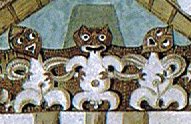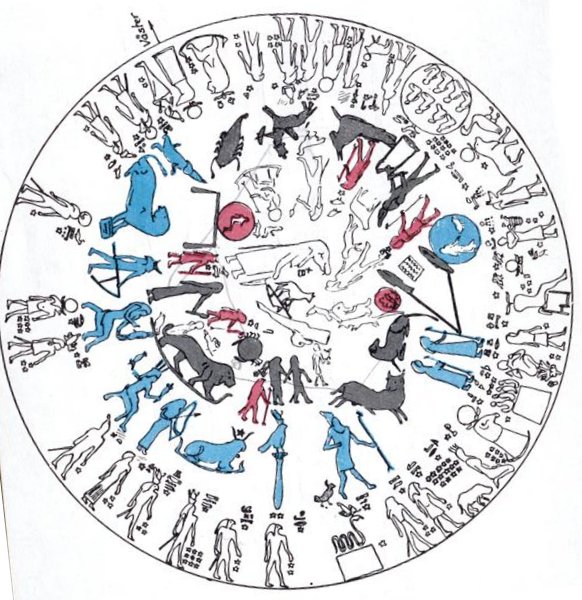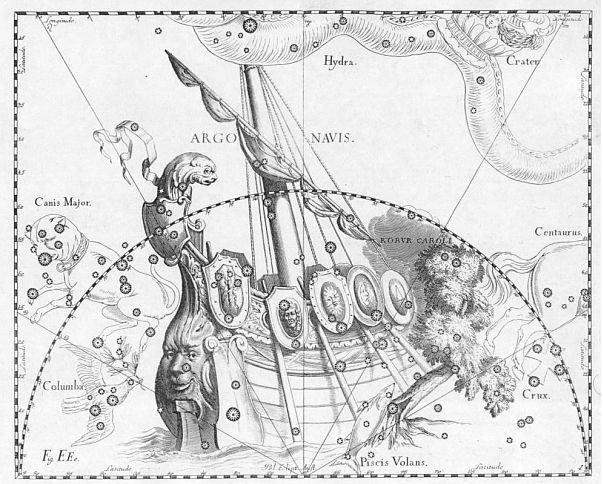|
TRANSLATIONS
Next page with the first of its
underpages:
|
Considering that
winter solstice presumably was allocated to glyph line Rb9 and that side a
corresponds to the front side of the year, it seems probable rona
in Ra2-9 is the winter season turning over:
 |
|
Ra2-9 |
If a 'person' is
falling on his face, we know it means we cannot see his face (mata)
any longer - he is finished. A 'person' inhabiting the dark side, on the
other side, should fall in another way at the point of his 'finish'.
He
should fall with the back of his head against the ground. Mutu
is the opposite of mata, I guess.
|
Mutu
1. Cut short, shortened, amputated; at an
end, ceased; anything cut off short; short, brief, quick
(rare). Ua muku ko'u lole, my dress is
shortened. He kanaka wāwae muku, a person with
amputated foot. Huli muku a'ela nā wa'a, the
canoes turned sharply. (PPN mutu.) 2. A measure
of length from fingertips of one hand to the elbow of
the other arm, when both arms are extended to the side.
3. Broken section of a wave or crest. See lala 1.
4. Same as Mumuku, a wind. 5. Thirtieth night
of the moon, when it has entirely disappeared (muku).
6. Starboard ends of 'iako (outrigger booms),
hence starboard sides of a canoe. Wehewehe. |
The front arm of
rona in Ra2-9 has 3 fingers, while his back side hand is
empty. Spring lies in front, winter in the past.
If we begin
counting from the last glyph on side b (even if we cannot see it),
and given that I have counted glyph line Ra1 right (as 25 more or less
visible glyphs + 5 missing glyphs), then Ra2-9 could be number 40. This
number (4 times 10) is congruent with those 4 which according to the Hawaiian moon
calendar belong in the next month:
|
26 Kane |
27 Lono |
28 Mauli |
29 Muku |
Tane (Kane)
is the god who will raise the sky roof high and the other 3 are
possibly needed
in order to keep it so. Though they are not strong enough, it
seems, because the process needs to be repeated again at the beginning of
each new light cycle. In the 2nd list of
place names the quartet seems to correspond to the end of page 39 in
Manuscript E:
|
26 |
ko
te
hakarava
a hakanohonoho. |
|
27 |
ko
hanga nui a te papa tata ika. |
|
28 |
ko
tongariki a henga eha tunu kioe hakaputiti.ai |
| |
ka
haka punenenene henua mo opoopo o tau kioe |
|
29 |
ko
te rano a raraku. |
Hakarava in
item 26 could be a sign of Tane, the spring maker. We must
here take the opportunity to enlarge (hakarava) our insight into the 'sacred'
geography of the island.
|
|
Let us begin with
an overview:

The high coastline
in the northern corner of the island, to the left and right of Cabo Norte, corresponds to the time
when light is at its maximum ('ebb'). The opposite side of the
island is the shore line
between Rano Kau and Rano Raraku which corresponds to
the 'horizontal' back side of the light cycle. The island can be
imagined as formed
like a canoe under full sail, with the top of its mast (tu'u) in
the north and with the sea below the canoe outside
the coastline in the south.
A canoe has a high
prow (rei mua) and a high stern (rei muri), which we immediately
can identify with the
southwestern high ground around Rano Kau respectively with
Poike ('the place aloft').
|
Rano Kau |
Rei Mua |
|
Rano Aroi |
Tu'u |
|
Rano Raraku |
Rei Muri |
...
The higher-ranked of the two largest political units on Rapa Nui
was the Ko Tu'u Aro Ko Te Mata Nui. This literally translates
as The Mast/Pillar/Post Before the Greater Tribes ...
The triangular
form of Easter Island is underlined by the locations of the 3 great craters.
Waves lapping in the south are depicted between the heads of the 3
'swimmers' in the Taranaki storehouse:

The central Sun 'cat'
is male and he is linked to his two Moon 'wives'. They correspond to Rano Kau and Rano Raraku,
while the 'cat' himself has the position of 'mast'. Waxing Moon is at
left and Waning at right we can read from the whites in their eyes.
As to Aroi
it is useful to begin its translation with aro:
| Aro
Face, front, side (of a figure); ki te
aro o ..., to the front of ... Vanaga.
Presence, body, frontispiece; ki te
aro, face to face. P Pau.: aroga, the visage;
ki te aroga, opposite. Mgv.: aro,
presence, before; i te aro, in the presence of.
Mq.: aó, face, in the presence of, before. Ta.:
aro, face, front, presence, view. It is probable
that more than one word is confounded in alo. The
significations which appear in Southeast Polynesia are
most likely derived from a Tongafiti alo and do
not appear in Nuclear Polynesia. The alo belly
and alo chief which do occur in Nuclear Polynesia
are also probably Tongafiti, for in Samoa and Tonga they
are honorific and applied only to folk of rank, a good
indication of borrowing by the Proto-Samoans from
Tongafiti masters. Churchill.
In the Hawaiian group, the western
portion or side of an island was called 'the front',
ke alo, of the land, and the eastern side was called
'the back', ke kua. The reason of such
designations must be sought in the fact of the arrival
of the inhabitants from the west. Fornander. |
Fornander's explanation of arrival from the west is not acceptable.
Although Argo has only its stern visible in the
west while
its prow is 'drinking water' in the east I think this is a
special case.
... Then the canoe
was made to drink salt water; it was dipped forwards and
backwards in the waves of the great moving altar of the gods and
thus consecrated to Tane ...
For some
universal reason the prow should be in the west, and a possible
explanation is that all the 'sky inhabitants' (excepting Moon) are moving from
east to west (like the water currents from the American
continent). Up must be in the east, because 'gravitation'
evidently moves things from east to west. With time they will
move down and to the west, down into the water.
Moon is the
primary time giver and she delivers, so to say, the events in
their proper order. They are born down in the west, to be met
with sooner or later in the general downward flow (increasing
entropy) from high up in the east. This seems to be not only a
reflection of the high mountains of the American continent but
a universal picture, and the same view may have been shared by the creator of the Dendera round zodiac, where the
zodiacal figures of the night are facing east and the rising Sun:

If we here read
from left to right it means to join Moon, moving from the future
towards the present. Life (light) is a force which can decrease
entropy.
|
|

(Drawn by Johannes
Hevelius)
According to a variety of sources of the legend, the Argo was said to
have been planned or constructed with the help of Athena. According to other
legends it contained in its prow a magical piece of timber from the sacred
forest of Dodona, which could speak and render prophecies.
Argo Navis is the only one of the 48 constellations listed by the 2nd
century astronomer Ptolemy that is no longer officially recognised as a
constellation. It was unwieldy due to its enormous size: were it still
considered a single constellation, it would be the largest of all. In
1752, the French astronomer Nicolas Louis de Lacaille subdivided it into
Carina (the keel, or the hull, of the ship), Puppis (the poop deck), and
Vela (the sails). When Argo Navis was split, its Bayer designations were
also split. Carina has the α, β and ε, Vela has γ and δ,
Puppis has ζ,
and so on.
The constellation Pyxis (the mariner's compass) occupies an
area which in antiquity was considered part of Argo's mast (called
Malus). However, Pyxis is not now considered part of Argo Navis, and its
Bayer designations are separate from those of Carina, Puppis and
Vela.
(Wikipedia)
|
When
reading the universal sign language of ancient man the first and
obvious rule is to react to what is unusual. Here we have an example in form of the only odd constellation of 48 which did not
survive up to modern times. It must have been banned, I guess, and
maybe for
some reason similar to why Ophiuchus did not survive
- although this constellation disappeared totally as described
earlier at Roto Iri Are (crf the excursion at hoea).
The
enormous size of ancient Argo Navis associates to how the whole of Easter
Island may have been likened to a great ship. Its
prow (which disappeared under the water) was a piece of magical
timber from the sacred forest of Dodona, but the picture
above suggests it was also the 'Tree':
"Robur
Carolinum, Charles' Oak, the Quercia of Italy and
the Karlseiche of Germany, was formally published by Halley
in 1679 in commemoration of the Royal Oak of his patron, Charles II,
in which the king had lain hidden for twenty-four hours after his
defeat by Cromwell in the battle of Worcester, on the 3rd of
September 1651." (Allen)
Myths
form history. Was the king really hidden in an oak for 24 hours?
Probably myth transformed the story, so that half 48 became the
duration of the hidden (absent) king - i.e. corresponding to the
degrees of latitute for the tropic of Capricorn.
Argo Navis was drawn by the tail of Canis Major
- cfr at toki - and this was presumably because the harbour had been
reached:
... Sternforward
Argō by the Great Dog's tail // Is drawn; for hers is not
a usual course, // But backward turned she comes, as vessels do //
When sailors have transposed the crooked stern // On entering
harbour; all the ship reverse, // And gliding backward on the beach
it grounds. // Sternforward thus is Jason's Argō drawn ...
Also in the rongorongo idiom
a sign of reversal means the journey
has ended:
Hevelius has above drawn the images of Sun and Moon in the
center (close to the mast respectively adjoining Sun at
right). Sun has stopped (he is drawn
en face) and his 'Tree' has toppled.
|
|
The meaning of the
Tane item (26) should be: making 'land' rise above 'water', I guess:
|
26 |
ko
te
hakarava
a hakanohonoho. |
|
27 |
ko
hanga nui a te papa tata ika. |
|
28 |
ko
tongariki a henga eha tunu kioe hakaputiti.ai |
| |
ka
haka punenenene henua mo opoopo o tau kioe |
|
29 |
ko
te rano a raraku. |
Te Hakarava is the slope
from the Poike plateau down to the bay of Hanga Nui.
Barthel translates hakanohonoho as 'to prepare a place to live
for the many (?)' which 'may be explained by the large
number of people who once lived in the hinterland of Hanga
Nui'.
The important aspect, though, ought instead to be to make clear what
hakarava here means, viz. presumably to enlarge the land (to live on), to make
'land' rise from 'water'. Barthel does not help much in
deciphering the true meanings of the place names. It was Te
Ohiro who saved the land from sinking into the sea:
...
Nga Tavake spoke to Te Ohiro: 'The land is sinking
into the sea and we are lost!' But Te Ohiro warded off
the danger with a magic chant ...
The season of waxing light (possibly Te Ohiro) corresponds to
'ebb', the time when the 'sea'
recedes.
If Tane has number 26 - being the Sun and maybe the
'creator' of the first
quarter of the year - then Rogo could be number 27.
Hanga Nui 'is the most important landing site on the
southeastern shore of Easter Island' and 'especially valued
as an excellent place for catching fish'. Barthel translates te
papa tata ika as 'the flat rock where the fishes are
washed'.
But tata can also mean e.g. appear, show up, strike:
|
Tata
Tata.
1. To wash something. 2. To go; he-tata-mai,
to come, to appear, to show up. Vanaga.
1. Agony, severe pain, apparent
death. 2. Next, proximity;
hakatata,
to bring close together. 3. To strike;
tata ei taura,
to flog, to lash. 4. To wash, to clean, to soap, to
rinse. 5. To appear, to approach, to advance, to
present; hakatata,
to advance, to propose, to accost. Churchill. |
The first day of
April is the first day of the 2nd quarter of the year, and
it is connected with a fish. Winter (the time of fishes) is
about to end, and the Icelanders had their 'summer year'
begining with April 14:
... the
Icelanders reckoned in misseri, half-years, not in
whole years, and the rune-staves divide the year into a
summer and a winter half, beginning on April 14 and October
14 respectively ...
I have compared April with Tangaroa Uri, cfr at vaha kai:
...
Tangaroa Uri is the month October, corresponding to
April north of the equator. April 1 is the date when we must
be aware lest somebody fools us. Only by trickery can summer
win over winter. As a little child there is no other way to
succeed.
The fishing
taboo is over and it is now OK to lift the fishes up (reva)
from the sea, haul them onto land. In French they have a
saying 'donner une poisson' (give a fish [as a
present to somebody]) which is said on April 1.
The winter
season is the season of Tagaroa and when he has been
defeated by the summer season there is no longer any danger
connected with handling fishes. The taboo is over. Thank you
for that! Hakakio should mean make (haka)
summer (kio).
The 'land'
has won, has returned, and Te Kioe Uri is another
expression of this. The Black Rat symbolizes the land rising
above the sea. It is 'ebb' again and the 'tidal flats' can
be scavenged to fill the empty stomachs. Also fishes can be
caught in the tidal pools ...
|
|





